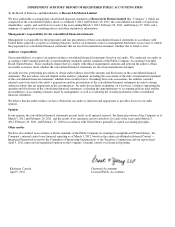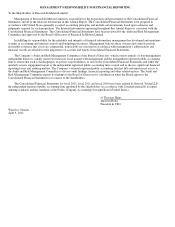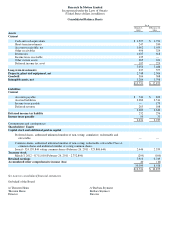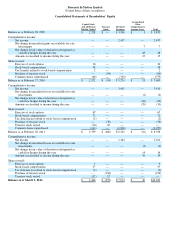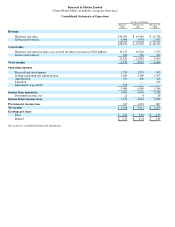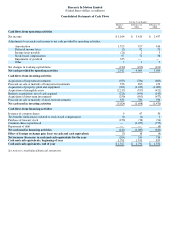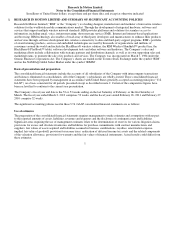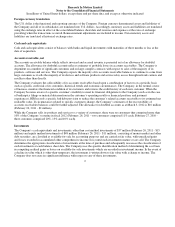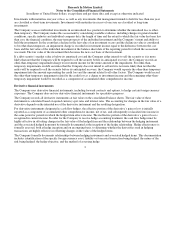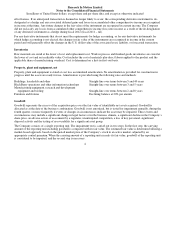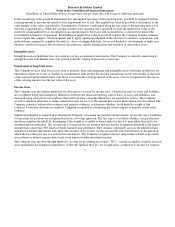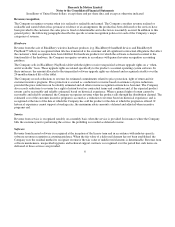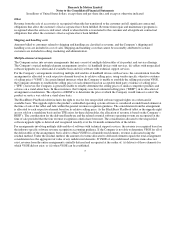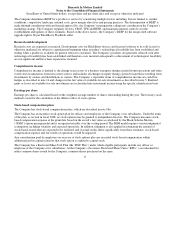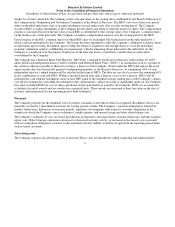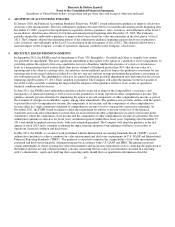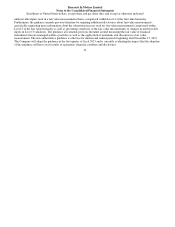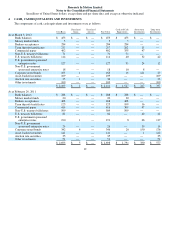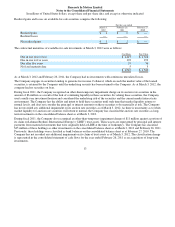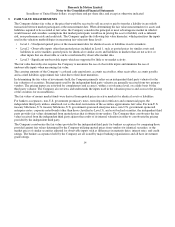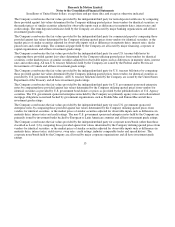Blackberry 2012 Annual Report Download - page 126
Download and view the complete annual report
Please find page 126 of the 2012 Blackberry annual report below. You can navigate through the pages in the report by either clicking on the pages listed below, or by using the keyword search tool below to find specific information within the annual report.
Research In Motion Limited
Notes to the Consolidated Financial Statements
In millions of United States dollars, except share and per share data, and except as otherwise indicated
In the second step of the goodwill impairment test, the implied fair value of the reporting unit’s goodwill is compared with its
carrying amount to measure the amount of the impairment loss, if any. The implied fair value of goodwill is determined in the
same manner as the value of goodwill is determined in a business combination using the fair value of the reporting unit as if it
were the acquisition price. When the carrying amount of the reporting unit’s goodwill exceeds the implied fair value of the
goodwill, an impairment loss is recognized in an amount equal to the excess and is presented as a separate line item in the
consolidated statements of operations. Establishing an implied fair value of goodwill requires the Company to make estimates
for key inputs into complex valuation models and to apply significant judgment in the selection of estimates, assumptions and
methodologies required to complete the analysis. Areas of judgment include, but are not limited to, development of multi-year
business cash flow forecasts, the selection of discount rates and the identification and valuation of unrecorded assets.
Intangible assets
Intangible assets with definite lives are stated at cost less accumulated amortization. The Company is currently amortizing its
intangible assets with definite lives over periods generally ranging between two to ten years.
Impairment of long-lived assets
The Company reviews long-lived assets such as property, plant and equipment and intangible assets with finite useful lives for
impairment whenever events or changes in circumstances indicate that the carrying amount may not be recoverable. If the total
of the expected undiscounted future cash flows is less than the carrying amount of the asset, a loss is recognized for the excess
of the carrying amount over the fair value of the asset.
Income taxes
The Company uses the liability method of tax allocation to account for income taxes. Deferred income tax assets and liabilities
are recognized based upon temporary differences between the financial reporting and tax bases of assets and liabilities, and
measured using enacted tax rates and laws that will be in effect when the differences are expected to reverse. The Company
records a valuation allowance to reduce deferred income tax assets to the amount that is more likely than not to be realized. The
Company considers both positive evidence and negative evidence, to determine whether, based upon the weight of that
evidence, a valuation allowance is required. Judgment is required in considering the relative impact of negative and positive
evidence.
Significant judgment is required in evaluating the Company’s uncertain tax positions and provisions for income taxes. Liabilities
for uncertain tax positions are recognized based on a two-step approach. The first step is to evaluate whether a tax position has
met the recognition threshold by determining if the weight of available evidence indicates that it is more likely than not to be
sustained upon examination. The second step is to measure the tax position that has met the recognition threshold as the largest
amount that is more than 50% likely of being realized upon settlement. The Company continually assesses the likelihood and
amount of potential adjustments and adjusts the income tax provisions, income tax payable and deferred taxes in the period in
which the facts that give rise to a revision become known. The Company recognizes interest and penalties related to uncertain
tax positions as interest expense that is netted and reported within investment income.
The Company uses the flow-through method to account for investment tax credits (“ITCs”) earned on eligible scientific research
and experimental development expenditures. Under this method, the ITCs are recognized as a reduction to income tax expense.
5


